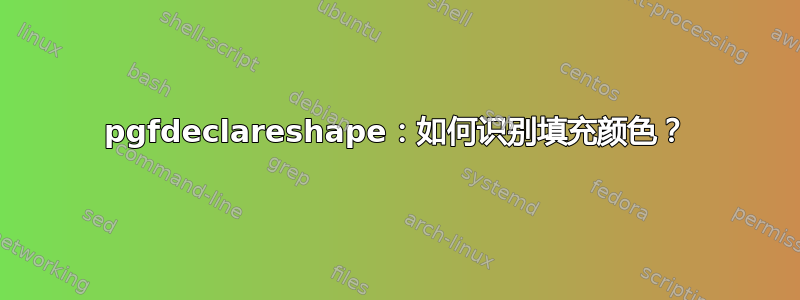
如果将自定义形状triangle设置为 之类的选项,则无法识别填充颜色(或描边颜色)fill=green。但它可以识别填充选项。我似乎遗漏了一些初始化代码(尽管我使用了\tikz@mode)。设置形状边框的颜色也存在同样的问题。
可执行文件中的代码如下所示:
\documentclass{article}
\usepackage{amsmath,amsfonts,amssymb,tikz}
\usetikzlibrary{shapes}
\usetikzlibrary{arrows,backgrounds}
\usetikzlibrary{decorations.pathreplacing}
\usetikzlibrary{decorations.markings}
\pgfdeclarelayer{foreground}
\pgfdeclarelayer{background}
\pgfsetlayers{main,foreground,background}
%
\newenvironment{pic}[1][]%
{\begin{aligned}\begin{tikzpicture}[#1]}%
{\end{tikzpicture}\end{aligned}}
%
% Styles
\tikzstyle{string}=[line width=1.25pt]
%%%%%%%%%%%%
% Triangle
\newlength\stateheight
\setlength\stateheight{0.6cm}
\newlength\minimumstatewidth
\setlength\minimumstatewidth{0.8cm}
\newif\ifhflip\pgfkeys{/tikz/hflip/.is if=hflip}
%%
%%
%%
\makeatletter
%%
%% triangle shape for states in categorical quantum computation
%% -- Based on some code by Chris Heunen,
%% -- expanded by BF.
%%
%% options: hflip (horizonatlly flipps the triangle)
%%
\pgfdeclareshape{triangle}
{% -- some dimensions
\saveddimen{\halfbaselength}{%
\pgf@x=0.5\wd\pgfnodeparttextbox
% get xsep
\pgfmathsetlength\pgf@xc{\pgfkeysvalueof{/pgf/inner xsep}}%
\advance\pgf@x by \pgf@xc%
% get \ht of textbox, add to baselength
\advance\pgf@x by \ht\pgfnodeparttextbox
% get minimum width
\pgfmathsetlength\pgf@xb{\pgfkeysvalueof{/pgf/minimum width}}%
\divide\pgf@xb by 2
\ifdim\pgf@x<\pgf@xb%
% yes, too small. Enlarge...
\pgf@x=\pgf@xb%
\fi%
}
%
% do NOT split code here \halfbaselinelength is pased on in \pgf@x
%
\saveddimen\triangleheight{%
% \pgf@x contains \halfbaselength
%get ysep
\pgfmathsetlength\pgf@xc{\pgfkeysvalueof{/pgf/inner ysep}}%
\advance\pgf@x by \pgf@xc%
%get minimum height
\pgfmathsetlength\pgf@xb{\pgfkeysvalueof{/pgf/minimum height}}%
\divide\pgf@xb by 2
\ifdim\pgf@x<\pgf@xb%
%yes, too small. Enlarge...
\pgf@x=\pgf@xb%
\fi%
}
% -- anchors
\savedanchor\centerpoint{% midpoint on base line
\pgf@x=0pt
\pgf@y=0pt
}
\anchor{center}{\centerpoint}
\anchor{text}{%
% horrizontal midpoint of pgfnodeparttextbox
\pgf@x=-0.5\wd\pgfnodeparttextbox
% vertical positioning (dependent on hflip flag)
\ifhflip
\pgf@y=-1.2\ht\pgfnodeparttextbox
\advance\pgf@y by \dp\pgfnodeparttextbox
\advance\pgf@y by -3pt
\else
\pgf@y=\dp\pgfnodeparttextbox
\advance\pgf@y by -\dp\pgfnodeparttextbox
\advance\pgf@y by 4pt
\fi
}
\anchor{left}{%
\pgf@x=-\halfbaselength
\pgf@y=0pt
}
\anchor{right}{%
\pgf@x=\halfbaselength
\pgf@y=0pt
}
\anchor{tip}{%
\pgf@x=0pt
\ifhflip
\pgf@y=-\triangleheight
\else
\pgf@y=\triangleheight
\fi
}
\anchor{a}{%
\pgf@x=-\halfbaselength
\divide\pgf@x by 2
\pgf@y=0pt
}
\anchor{b}{%
\pgf@x=\halfbaselength
\divide\pgf@x by 2
\pgf@y=0pt
}
%% -- draw the outline of the triangle
%% -- fill the triangle if necessary
\backgroundpath
{
\tikz@mode %% set stuff
\tikz@options %% needed??
% -- draw mode
\iftikz@mode@draw
\begin{pgfonlayer}{foreground}
\pgf@xa=\halfbaselength
\pgf@ya=\triangleheight
\ifhflip
\pgfpathmoveto{\pgfqpoint{0pt}{-\pgf@ya}}
\pgfpathlineto{\pgfqpoint{-\pgf@xa}{0pt}}
\pgfpathlineto{\pgfqpoint{\pgf@xa}{0pt}}
\pgfpathclose
\else
\pgfpathmoveto{\pgfqpoint{0pt}{\pgf@ya}}
\pgfpathlineto{\pgfqpoint{-\pgf@xa}{0pt}}
\pgfpathlineto{\pgfqpoint{\pgf@xa}{0pt}}
\pgfpathclose
\fi
\pgfusepath{stroke}
\end{pgfonlayer}
\fi
% -- fill mode
\iftikz@mode@fill
\begin{pgfonlayer}{background}
\pgf@xa=\halfbaselength
\pgf@ya=\triangleheight
\ifhflip
\pgfpathmoveto{\pgfqpoint{0pt}{-\pgf@ya}}
\pgfpathlineto{\pgfqpoint{-\pgf@xa}{0pt}}
\pgfpathlineto{\pgfqpoint{\pgf@xa}{0pt}}
\pgfpathclose
\else
\pgfpathmoveto{\pgfqpoint{0pt}{\pgf@ya}}
\pgfpathlineto{\pgfqpoint{-\pgf@xa}{0pt}}
\pgfpathlineto{\pgfqpoint{\pgf@xa}{0pt}}
\pgfpathclose
\fi
\pgfusepath{fill}
\end{pgfonlayer}
\fi
}
\anchorborder
{% -- works only on the base line (yet)
% -- range restricted to 0..100
% fetch key
\pgfkeysgetvalue{/pgf/shape border rotate}{\rotate}%
%
% Save x and y.
%
\edef\externalx{\the\pgf@x}%
\edef\externaly{\the\pgf@y}%
%
% Adjust the location of the external
% point relative to \centerpoint.
%
\centerpoint%
\pgf@xa\externalx\relax%
\pgf@ya\externaly\relax%
\advance\pgf@xa\pgf@x%
\advance\pgf@ya\pgf@y%
\edef\externalx{\the\pgf@xa}%
\edef\externaly{\the\pgf@ya}%
%
% Get the angle of the external point to the \centerpoint.
%
\pgfmathanglebetweenpoints{\centerpoint}{\pgfqpoint{\externalx}{\externaly}}%
\pgfmathsubtract@{\pgfmathresult}{\rotate}%
\ifdim\pgfmathresult pt<0pt\relax%
\pgfmathadd@{\pgfmathresult}{360}%
\fi%
\let\externalangle\pgfmathresult%
%
% left tip
%
\pgf@xc=-\halfbaselength
\pgf@yc=0pt
%
% we use a border parameter in the range 0..100 to parametrize
% the base line from left to right, 50 is the center
% hence \externalangle/50 gives the multiplicator for the
% \halfbaseline (2\halfbaseline is the length of the baseline)
%
\pgfmathdivide@{\externalangle}{50}
\pgfmathparse{\halfbaselength*\pgfmathresult}
\advance\pgf@xc by \pgfmathresult pt%
%
% set the anchor point
%
\pgf@y=0pt
\pgf@x=\pgf@xc
}
}
\makeatother
\begin{document}
\begin{align*}
\begin{pic}
\node (o1) at (0,1) {};
\node (o2) at (1,1) {};
\node (o3) at (2,1) {};
\node[triangle,draw,blue,string,hflip] (t1) at (0,0) {};
\node[triangle,fill=blue!40,string,hflip] (t2) at (1,0) {};
\node[triangle,draw,fill=green,string,hflip] (t3) at (2,0) {};
\draw[blue] (o1) to (t1.center);
\draw (o2) to (t2.center);
\draw (o3) to (t3.75) (o3) to (t3.25); % tests anchorborder
\end{pic}
\end{align*}
\end{document}
结果如下:

我还必须处理 \anchorborder 位,但我想我可以自己做,因为它已经在三角形的一侧起作用了。
非常感谢任何帮助以及对我的代码错误原因的解释。
答案1
无需使用\tikz@mode@fill或 图层(这会导致颜色丢失)或\pgfusepath。PGF 会自动处理这些事情。

\documentclass{article}
\usepackage{amsmath,amsfonts,amssymb,tikz}
\usetikzlibrary{shapes}
\usetikzlibrary{arrows,backgrounds}
\usetikzlibrary{decorations.pathreplacing}
\usetikzlibrary{decorations.markings}
\pgfdeclarelayer{foreground}
\pgfdeclarelayer{background}
\pgfsetlayers{main,foreground,background}
%
\newenvironment{pic}[1][]%
{\begin{aligned}\begin{tikzpicture}[#1]}%
{\end{tikzpicture}\end{aligned}}
%
% Styles
\tikzstyle{string}=[line width=1.25pt]
%%%%%%%%%%%%
% Triangle
\newlength\stateheight
\setlength\stateheight{0.6cm}
\newlength\minimumstatewidth
\setlength\minimumstatewidth{0.8cm}
\newif\ifhflip\pgfkeys{/tikz/hflip/.is if=hflip}
%%
%%
%%
\makeatletter
%%
%% triangle shape for states in categorical quantum computation
%% -- Based on some code by Chris Heunen,
%% -- expanded by BF.
%%
%% options: hflip (horizonatlly flipps the triangle)
%%
\pgfdeclareshape{triangle}
{% -- some dimensions
\saveddimen{\halfbaselength}{%
\pgf@x=0.5\wd\pgfnodeparttextbox
% get xsep
\pgfmathsetlength\pgf@xc{\pgfkeysvalueof{/pgf/inner xsep}}%
\advance\pgf@x by \pgf@xc%
% get \ht of textbox, add to baselength
\advance\pgf@x by \ht\pgfnodeparttextbox
% get minimum width
\pgfmathsetlength\pgf@xb{\pgfkeysvalueof{/pgf/minimum width}}%
\divide\pgf@xb by 2
\ifdim\pgf@x<\pgf@xb%
% yes, too small. Enlarge...
\pgf@x=\pgf@xb%
\fi%
}
%
% do NOT split code here \halfbaselinelength is pased on in \pgf@x
%
\saveddimen\triangleheight{%
% \pgf@x contains \halfbaselength
%get ysep
\pgfmathsetlength\pgf@xc{\pgfkeysvalueof{/pgf/inner ysep}}%
\advance\pgf@x by \pgf@xc%
%get minimum height
\pgfmathsetlength\pgf@xb{\pgfkeysvalueof{/pgf/minimum height}}%
\divide\pgf@xb by 2
\ifdim\pgf@x<\pgf@xb%
%yes, too small. Enlarge...
\pgf@x=\pgf@xb%
\fi%
}
% -- anchors
\savedanchor\centerpoint{% midpoint on base line
\pgf@x=0pt
\pgf@y=0pt
}
\anchor{center}{\centerpoint}
\anchor{text}{%
% horrizontal midpoint of pgfnodeparttextbox
\pgf@x=-0.5\wd\pgfnodeparttextbox
% vertical positioning (dependent on hflip flag)
\ifhflip
\pgf@y=-1.2\ht\pgfnodeparttextbox
\advance\pgf@y by \dp\pgfnodeparttextbox
\advance\pgf@y by -3pt
\else
\pgf@y=\dp\pgfnodeparttextbox
\advance\pgf@y by -\dp\pgfnodeparttextbox
\advance\pgf@y by 4pt
\fi
}
\anchor{left}{%
\pgf@x=-\halfbaselength
\pgf@y=0pt
}
\anchor{right}{%
\pgf@x=\halfbaselength
\pgf@y=0pt
}
\anchor{tip}{%
\pgf@x=0pt
\ifhflip
\pgf@y=-\triangleheight
\else
\pgf@y=\triangleheight
\fi
}
\anchor{a}{%
\pgf@x=-\halfbaselength
\divide\pgf@x by 2
\pgf@y=0pt
}
\anchor{b}{%
\pgf@x=\halfbaselength
\divide\pgf@x by 2
\pgf@y=0pt
}
%% -- draw the outline of the triangle
%% -- fill the triangle if necessary
\backgroundpath
{
% -- draw mode
\pgf@xa=\halfbaselength
\pgf@ya=\triangleheight
\ifhflip
\pgfpathmoveto{\pgfqpoint{0pt}{-\pgf@ya}}
\pgfpathlineto{\pgfqpoint{-\pgf@xa}{0pt}}
\pgfpathlineto{\pgfqpoint{\pgf@xa}{0pt}}
\pgfpathclose
\else
\pgfpathmoveto{\pgfqpoint{0pt}{\pgf@ya}}
\pgfpathlineto{\pgfqpoint{-\pgf@xa}{0pt}}
\pgfpathlineto{\pgfqpoint{\pgf@xa}{0pt}}
\pgfpathclose
\fi
}
\anchorborder
{% -- works only on the base line (yet)
% -- range restricted to 0..100
% fetch key
\pgfkeysgetvalue{/pgf/shape border rotate}{\rotate}%
%
% Save x and y.
%
\edef\externalx{\the\pgf@x}%
\edef\externaly{\the\pgf@y}%
%
% Adjust the location of the external
% point relative to \centerpoint.
%
\centerpoint%
\pgf@xa\externalx\relax%
\pgf@ya\externaly\relax%
\advance\pgf@xa\pgf@x%
\advance\pgf@ya\pgf@y%
\edef\externalx{\the\pgf@xa}%
\edef\externaly{\the\pgf@ya}%
%
% Get the angle of the external point to the \centerpoint.
%
\pgfmathanglebetweenpoints{\centerpoint}{\pgfqpoint{\externalx}{\externaly}}%
\pgfmathsubtract@{\pgfmathresult}{\rotate}%
\ifdim\pgfmathresult pt<0pt\relax%
\pgfmathadd@{\pgfmathresult}{360}%
\fi%
\let\externalangle\pgfmathresult%
%
% left tip
%
\pgf@xc=-\halfbaselength
\pgf@yc=0pt
%
% we use a border parameter in the range 0..100 to parametrize
% the base line from left to right, 50 is the center
% hence \externalangle/50 gives the multiplicator for the
% \halfbaseline (2\halfbaseline is the length of the baseline)
%
\pgfmathdivide@{\externalangle}{50}
\pgfmathparse{\halfbaselength*\pgfmathresult}
\advance\pgf@xc by \pgfmathresult pt%
%
% set the anchor point
%
\pgf@y=0pt
\pgf@x=\pgf@xc
}
}
\makeatother
\begin{document}
\begin{align*}
\begin{pic}
\node (o1) at (0,1) {};
\node (o2) at (1,1) {};
\node (o3) at (2,1) {};
\node[triangle,draw,blue,string,hflip] (t1) at (0,0) {};
\node[triangle,fill=blue!40,string,hflip] (t2) at (1,0) {};
\node[triangle,draw,fill=green,string,hflip] (t3) at (2,0) {};
\draw[blue] (o1) to (t1.center);
\draw (o2) to (t2.center);
\draw (o3) to (t3.75) (o3) to (t3.25); % tests anchorborder
\end{pic}
\end{align*}
\end{document}


